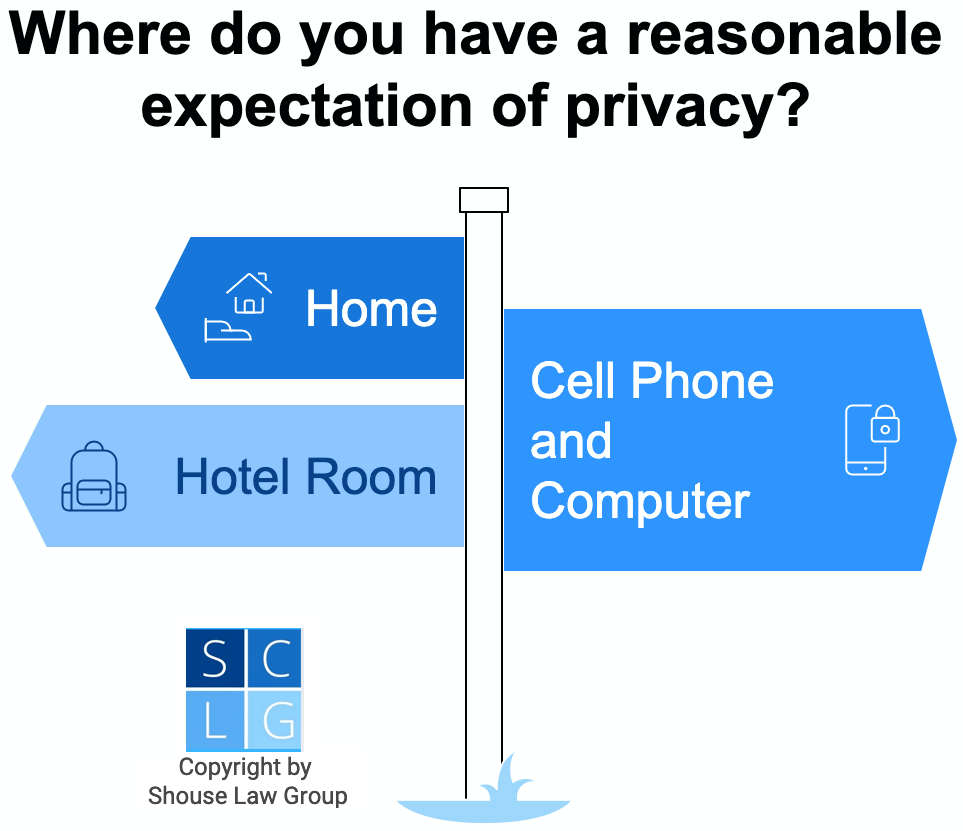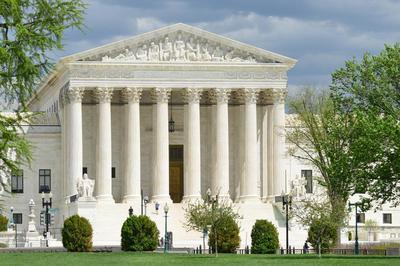California search and seizure laws protect you from unreasonable police intrusion into your home, vehicles, person and other property. These protections are grounded in state law and the Fourth Amendment to the U.S. Constitution.
If you are a victim of illegal searches, you can seek to get any illegally-obtained evidence excluded from the trial.
This applies both to actions by
- federal law enforcement (such as the FBI), and
- to searches by state and local police that lead to criminal charges in California state court. 1 2
The Fourth Amendment’s rule against unreasonable search and seizures means that police may not search you or your property unless one of the following is true:
- They have obtained a valid search warrant from a judge, OR
- The search falls within one of a number of exceptions to the warrant requirement recognized by federal and California courts.3

Exceptions to the Warrant Requirement
Exceptions to the rule that police searches and seizures require a warrant vary depending on the type of property that is being searched.
For example, the exceptions that apply to police searches of cell phones are different from those that apply to police searches of vehicles.
But, generally speaking, exceptions to the warrant requirement for searches and seizures exist for:
- Searches/seizures done with your voluntary consent;4
- Searches/seizures incident to a lawful arrest, where the police are looking either for weapons that might be used against them or for criminal evidence that might otherwise be destroyed;5
- Inspection searches, such as those at international borders;6
- Searches of vehicles when police have “probable cause” to believe the vehicle contains evidence about a crime (this is known as the “automobile exception” to the warrant requirement);7
- Searches of obviously incriminating items that are in “plain view” while law enforcement is conducting an otherwise lawful search;8
- Searches/seizures in emergency situations that are necessary to prevent physical harm or serious property damage, or to locate a fleeing suspect;9
- If police suspect you of criminal activity, a “stop and frisk” (that is, a search of your outer clothing) while you are being temporarily detained (this is sometimes referred to as a “Terry stop”), to look for weapons that might be used against an officer;10 and
- Searches in situations where you have no reasonable expectation of privacy.11
What happens if I am the victim of an unlawful search or seizure?
If you are the victim of an unlawful search or seizure by police, then you and your California criminal defense attorney can ask the court to exclude this evidence in your case. This is what is known as the “exclusionary rule.”12
This is usually done through a Penal Code 1538.5 PC motion to suppress evidence, which is an important kind of California pretrial motion.13
In order to help you better understand your rights, our California criminal defense attorneys will address the following topics re. searches and seizures:
- 1. Reasonable Expectation of Privacy
- 2. Search Warrants
- 3. Exceptions
- 4. Exclusionary Rule
- Additional Reading
1. Reasonable Expectation of Privacy
Search and seizure laws in California have their origins in:
- The Fourth Amendment to the U.S. Constitution,14 and
- Article I, Section 13, of the California Constitution.15
These constitutional sections provide that all citizens have the right to be free from “unreasonable searches and seizures.”16
But, as a general matter, you are only protected against unreasonable searches and seizures of property in which you have an “expectation of privacy” that is “reasonable.”17
As Oakland criminal defense attorney Neil Shouse18 puts it:
“You may personally believe that you have a ‘reasonable expectation of privacy’ in certain property—but that doesn’t necessarily mean you have Fourth Amendment protections for that property. Under search and seizure law in California, the issue is whether you have a legitimate reasonable expectation of privacy—that is, one that the rest of society would accept as reasonable.”
Here are some examples of places/property in which you have a legitimate expectation of privacy that protects you from searches and seizures:
- Your home,19
- Your cell phone, computer, and other electronic storage devices,20
- A tent or tarp,21
- A hotel room,22 and
- Personal property that public school students bring to school.23
Example: Bob is selling drugs out of a tent in a campground. Police show up, search the tent without a warrant, find cocaine, and arrest him for drug possession for sale. Though the cocaine cannot come in as evidence because Bob had a legitimate, reasonable expectation of privacy in his tent—and so the police did not have the right to search it without a warrant.24

You probably do not have a legitimate expectation of privacy in property you have thrown away.
Here are some kinds of property in which courts have ruled that you do not have a reasonable expectation of privacy:
- Property that you have abandoned;25
- The contents of a stolen vehicle;26 and
- Property inside a vehicle, if you are a passenger in the vehicle and do not own or have any possessory interest in either the vehicle or that property.27
Example: Richard rents a motel room for one night but never checks out or pays extra. After three nights, the motel manager notices that the window to Richard’s room is broken and calls the police. They search the room without a warrant and find items that tie Richard to a recent nearby burglary. Since Richard is considered to have abandoned the room, any items left there can come in as evidence.28
Of course, having a legitimate expectation of privacy in property does not mean that police may not search or seize that property. It just means that they may only do so if:
- They have a search warrant, or
- One of the exceptions to the warrant requirement applies.29

A search warrant must be authorized by a state or federal judge.
2. Search Warrants
Many searches/seizures in California are constitutional because they are done with a valid search warrant.
A search warrant must be authorized by a state or federal judge.30 Warrants grant police the right to search for and/or seize items that either
- may be evidence that a California felony has been committed, or
- may be evidence that a particular person has committed a felony.31
In order to be valid, a search warrant must be based on “probable cause” and must describe specifically both
- the area to be searched, and
- the property or thing that is being searched for.32
Example: Based on a victim’s statement, a police officer gets a warrant to search an apartment rented to convicted felon Scott, who the police believe is a child pornography dealer. The warrant specifies that it covers only that apartment, and authorizes a search for child pornography materials.
Challenging a Search or Seizure Authorized by a Warrant
Not all searches and seizures done with warrants will be constitutional. It is possible to challenge the admission of evidence from a search even if the search was done with a warrant—IF either of the following is true:
- The warrant itself was somehow defective or invalid, OR
- The search exceeded the scope of the warrant, or yielded evidence other than that described in the warrant.33
Example: When police in the above example search Scott’s apartment, all they find is a large stash of firearms. Though since the guns were not described in the warrant, they cannot come in as evidence of Scott being a felon with a firearm.
Reasons that a search warrant itself might be invalid or defective include:
- A police officer deliberately misled the judge about the facts justifying the warrant (a form of police misconduct that is all too common);
- The warrant was not specific enough about the area to be searched or the type of evidence to be searched for; and/or
- The judge who issued the warrant was biased.34

The U.S. Supreme Court has carved out a number of exceptions to the warrant requirement for searches and seizures.
3. Exceptions
Some searches or seizures of places/property in which you have a legitimate expectation of privacy are valid even if they were done without a warrant—as long as they fall into one of a long list of widely-recognized “exceptions” to the warrant requirement.
In this section, we discuss some of the most common places/property that police will search—and the warrant exceptions that apply for each of these.
Exceptions for Searches of Homes/Residences
Police may enter and search your house, apartment, trailer, etc., without a warrant, when one of the following circumstances applies:
- You (or someone else with authority over the premises) have given your consent to a search of your home;35
- There is imminent danger to life or a threat of serious damage to property;36 or
- The search takes place in connection with a lawful arrest—and is done either for the purpose of protecting the safety of the arresting officers, or for the purpose of safeguarding evidence about the arrest offense that someone might otherwise be able to destroy.37
Example: The police go to a suspect’s house without a warrant. The suspect is not home, but his girlfriend who lives there lets them search. Since the live-in girlfriend consented to the search, any evidence the police find can come in as evidence.38
Exceptions for Searches of Vehicles

Police may search your car without a warrant under certain circumstances.
Police searches of cars without a warrant may take place when any of the following is true:
- You (or someone else with authority to do so) have given your consent to a search of your vehicle;39
- The police have “probable cause” to believe the car contains contraband or evidence of a crime;40
- The police are lawfully arresting an occupant of the car—and either the arrestee is within reaching distance of the interior of the car, or it is reasonable to believe the car contains evidence about the crime for which they are being arrested;41
- The police are temporarily detaining an occupant of the car via a Terry stop, and reasonably believe that they may be dangerous and have access to weapons stored in the car;42 or
- The car has been lawfully impounded by law enforcement (as may happen if you commit Vehicle Code 14601 driving on a suspended license), and they are conducting an “inventory search.”43
Example: The police signal for a swerving driver to pull over, but the driver leads the police on a high-speed chase. Once the police catch up with the driver, they search the car and find marijuana hidden under a seat. The driver’s behavior of speeding away created probable cause to justify a vehicle search, so the marijuana could probably come in as evidence against the driver.44
Example: Steven gets arrested for DUI. During the inventory search of his car before it gets impounded, the police officer finds drugs and cash. This can be admitted as evidence if Steven is then charged with possession for sale because the inventory search was lawful.45
Exceptions for Searches of Cell Phones and Computers
Police may search your cell phone—or conduct a search of your computer or hard drive, tablet computer, or another electronic device—without a warrant, under the following circumstances:
- When you or someone else with authority over the phone/computer/electronic device consents to the search/seizure;46
- In an emergency situation, where police can show an immediate need to search a device in order to pursue a fleeing suspect, or assist someone who is seriously injured or threatened with imminent injury;47 or
- When you are carrying the device across an international border (including at airports).48
Example: Andrea and José are two undercover police detectives. José suspects that a certain gang member kidnapped Andrea after discovering her identity. There is no time to get a warrant, so the police go to the gang member’s computer and search it for clues. This computer search is probably not illegal, because it was done in an emergency in order to prevent physical injury to Andrea.
Also, even if none of the above exceptions apply, police may seize (and not search) your phone or computer if you are under arrest—and hold onto it until they can get a warrant to search it. They may do this to prevent the destruction of criminal evidence that may be on the electronic device.49
Finally, if police in California searched your cell phone without a warrant before June 25, 2014, while you were under lawful arrest, prosecutors probably can use that evidence against you.50
This is because—prior to that date—the law in California was such that warrantless cell phone searches under these circumstances were legal.51

Warrantless cellphone searches incident to arrest were legal in California prior to June 2014.
Example: In 2013, police conducted a warrantless search of Paul’s phone during a traffic stop and found child porn, which led to Paul being charged. In June 2014, the U.S. Supreme Court made clear that the warrantless search of Paul’s phone is now illegal. Though the images remain admissible as evidence because the police were acting in good faith in accordance with California law at the time.52
The “Plain View” Exception
The “plain view” exception is another important exception to the warrant rule for California searches and seizures.
Basically, the plain view exception says that when police are searching property legally (with a warrant, or under a warrant exception), they may also search any items that are
- in “plain view” while they are conducting their search, and
- obviously incriminating.53
Example: Police get a search warrant to search Sarah’s house for items she allegedly stole during an armed robbery. While there they see on her dresser a gun matching a description of the gun Sarah allegedly used. Even though the gun was not in the search warrant, it can come in as evidence because it was found in plain view and obviously tied Sarah to the robbery.54
4. Exclusionary Rule
If you are the victim of an illegal search or seizure, then you have the right to have any evidence that the police obtained through that search or seizure “suppressed.” This means that the evidence may not be used against you in your criminal jury trial.55
This is what is known as the “exclusionary rule” in California law.56
Your criminal defense attorney can challenge any evidence from an invalid search/seizure by filing a Penal Code 1538.5 motion to suppress evidence, prior to the start of your trial.57
If the motion is granted—and that evidence is key to the prosecution’s case against you—then you may be able to get the charges against you reduced, or even dismissed altogether.
“Fruit of the Poisonous Tree”
The “exclusionary rule” applies not just to evidence that was discovered during an illegal search—but also to evidence that police found as an indirect result of an illegal search.58
This is what is known as the “fruit of the poisonous tree” doctrine.59
The “poisonous tree” is the unlawful search or seizure, and the “fruit” is any evidence that the police manage to uncover as an indirect result of the unlawful search or seizure.
Example: Police suspect that Courtney has been involved in a murder. They conduct a warrantless search of her home without her there. The only thing they find is a hotel key, so they get a search warrant to search the hotel room where they find the murder weapon. Though since the weapon was a fruit of the poisonous tree (the unlawful home search), the weapon cannot come in as evidence.
However, prosecutors may be able to get around the “fruit of the poisonous tree” rule by making one of the following arguments:
- The evidence is far enough removed from the illegal search/seizure that the exclusionary rule no longer applies to it;60
- The evidence was found through an independent channel, not just through the illegal search;61 or
- There is a “reasonably strong probability” that police would have found the evidence even without the illegal search.62

The Fourth Amendment to the U.S. Constitution protects you from unreasonable searches and seizures.
Additional Reading
For more in-depth information, refer to these scholarly articles:
- Warrantless Search Cases Are Really All the Same – Minnesota Law Review.
- Is It Reasonable? A Legal Review of Warrantless Searches of Probationers and Parolees – Criminal Justice Policy Review.
- Search Warrants, Motions to Suppress and Lost Cases: The Effects of the Exclusionary Rule in Seven Jurisdictions – Journal of Criminal Law & Criminology.
- Press One for Warrant: Reinventing the Fourth Amendment’s Search Warrant Requirement through Electronic Procedures – Vanderbilt Law Review.
- The Post-Riley Search Warrant: Search Protocols and Particularity in Cell Phone Searches – Vanderbilt Law Review.
Legal References:
- U.S. Const., amend. IV. (“The right of the people to be secure in their persons, houses, papers, and effects, against unreasonable searches and seizures, shall not be violated, and no warrants shall issue, but upon probable cause, supported by oath or affirmation, and particularly describing the place to be searched, and the persons or things to be seized.”)
- Mapp v. Ohio (1961) 367 U.S. 643, 655. (“We hold that all evidence obtained by searches and seizures in violation of the Constitution is, by that same authority, inadmissible in a state court.”)
- For example, Riley v. California (2014) 134 S.Ct. 2473, 2482. (“In the absence of a warrant, a search is reasonable only if it falls within a specific exception to the warrant requirement.”)
- Schneckloth v. Bustamonte (1973) 412 U.S. 218, 219. (“It is equally well settled that one of the specifically established exceptions to the requirements of both a warrant and probable cause is a search [or seizure] that is conducted pursuant to consent.”). See also People v. Clymer (Cal. App. 2024) .
- Chimel v. California (1969) 395 U.S. 752, 762-63. (“A similar analysis underlies the ‘search incident to arrest’ principle [in the law of searches and seizures], and marks its proper extent. When an arrest is made, it is reasonable for the arresting officer to search the person arrested in order to remove any weapons that the latter might seek to use in order to resist arrest or effect his escape. Otherwise, the officer’s safety might well be endangered, and the arrest itself frustrated. In addition, it is entirely reasonable for the arresting officer to search for and seize any evidence on the arrestee’s person in order to prevent its concealment or destruction. And the area into which an arrestee might reach in order to grab a weapon or evidentiary items must, of course, be governed by a like rule.”)
- United States v. Arnold (9th Cir. 2008) 523 F.3d 941, 945. (“Courts have long held that searches of closed containers and their contents can be conducted at the border without particularized suspicion under the Fourth Amendment.”)
- Carroll v. United States (1925) 267 U.S. 132, 155. (“It follows from this that, if an officer seizes an automobile or the liquor in it without a warrant, and the facts as subsequently developed do not justify a judgment of condemnation and forfeiture, the officer may escape costs or a suit for damages by a showing that he had reasonable or probable cause for the [search and] seizure.”).
- Horton v. California (1990) 496 U.S. 128, 136. (“What the ‘plain view’ [search and seizure] cases have in common is that the police officer in each of them had a prior justification for an intrusion in the course of which he came inadvertently across a piece of evidence incriminating the accused.”)
- People v. Ray (1999) 21 Cal.4th 464, 472. (“This justification [emergency exception to warrant requirement for searches & seizures] requires specific, articulable facts indicating the need for ‘swift action to prevent imminent danger to life or serious damage to property . . . .’”)
- Terry v. Ohio (1968) 392 U.S. 1, 30-31. (“We merely hold today that where a police officer observes unusual conduct which leads him reasonably to conclude in light of his experience that criminal activity may be afoot and that the persons with whom he is dealing may be armed and presently dangerous, where in the course of investigating this behavior he identifies himself as a policeman and makes reasonable inquiries, and where nothing in the initial stages of the encounter serves to dispel his reasonable fear for his own or others’ safety, he is entitled for the protection of himself and others in the area to conduct a carefully limited search of the outer clothing of such persons in an attempt to discover weapons which might be used to assault him. Such a search is a reasonable search under the Fourth Amendment, and any weapons seized may properly be introduced in evidence against the person from whom they were taken.”)
- See, for example, People v. Parson (2008) 44 Cal.4th 332, 345. (“It has long been settled, however, that a warrantless search and seizure involving abandoned property is not unlawful, because a person has no reasonable expectation of privacy in such property.”)
- Mapp v. Ohio, endnote 2, above, at 657. (“Moreover, our holding that the exclusionary rule is an essential part of both the Fourth and Fourteenth Amendments is not only the logical dictate of prior cases, but it also makes very good sense.”)
- Penal Code 1538.5 PC – Motion to . . . suppress evidence [from an illegal search or seizure]. (“(a)(1) A defendant may move for the return of property or to suppress as evidence any tangible or intangible thing obtained as a result of a search or seizure on either of the following grounds: (A) The search or seizure without a warrant [including a warrantless search of a residence] was unreasonable. (B) The search or seizure with a warrant was unreasonable because any of the following apply: (i) The warrant is insufficient on its face. (ii) The property or evidence obtained is not that described in the warrant. (iii) There was not probable cause for the issuance of the warrant. (iv) The method of execution of the warrant violated federal or state constitutional standards. (v) There was any other violation of federal or state constitutional standards.”)
- U.S. Const., amend. IV, endnote 1, above.
- Cal. Const., Art. I, Sec. 13. (“The right of the people to be secure in their persons, houses, papers, and effects against unreasonable seizures and searches may not be violated; and a warrant may not issue except on probable cause, supported by oath or affirmation, particularly describing the place to be searched and the persons and things to be seized.”)
- See endnotes 14 and 15 above.
- Katz v. United States (1967) 389 U.S. 347, 361 (Harlan, J., concurring).
- Oakland criminal defense attorney Neil Shouse is the Managing Attorney of Shouse Law Group. He is a former Los Angeles County Deputy District Attorney, where he worked on complex, high profile gang, murder, and firearms cases. Now, Shouse has turned the inside knowledge he gained as a prosecutor into extraordinary expertise in criminal defense law and California evidence rules . . . thanks to which he frequently appears as a guest legal commentator on national television. He has a strong track record of successful motions to suppress evidence based on illegal and unconstitutional searches or seizures by police.
- Katz v. United States, endnote 17, above. (“Thus a man’s home is, for most purposes, a place where he expects privacy, but objects, activities, or statements that he exposes to the ‘plain view’ of outsiders are not ‘protected’ [from searches and seizures] because no intention to keep them to himself has been exhibited.”)
- Riley v. California, endnote 3, above, at 2491. (“Indeed, a cell phone search would typically expose to the government far more than the most exhaustive search of a house: A phone not only contains in digital form many sensitive records previously found in the home; it also contains a broad array of private information never found in a home in any form—unless the phone is.”)
- People v. Hughston (2008) 168 Cal.App.4th 1062, 1070-71. (“As the Colorado Supreme Court reasoned in Schafer, supra, 946 P.2d at p. 944: “Whether pitched on vacant open land or in a crowded campground, a tent screens the inhabitant therein from public view. Though it cannot be secured by a deadbolt and can be entered by those who respect not others, the thin walls of a tent nonetheless are notice of its occupant’s claim to privacy unless consent to enter be asked and given. One should be free to depart the campsite for the day’s adventure without fear of this expectation of privacy being violated. Whether of short or longer term duration, one’s occupation of a tent is entitled to equivalent protection from unreasonable government intrusion [through an illegal search or seizure] as that afforded to homes or hotel rooms.”)
- See same.
- In re Lisa G. (2004) 125 Cal.App.4th 801, 808. (“On the other hand, students in public schools have a legitimate expectation of privacy in the personal effects they bring to school. (In re Cody S. (2004) 121 Cal.App.4th 86, 91, 16 Cal.Rptr.3d 653.) They may “carry with them a variety of legitimate, noncontraband items, and there is no reason to conclude that they have necessarily waived all rights to privacy in such items merely by bringing them onto school grounds.” (New Jersey v. T.L.O., supra, 469 U.S. at p. 339, 105 S.Ct. 733.) We conclude Ms. Craig’s initial limited search of Lisa’s purse for identification was unreasonable [as a search/seizure] under the Fourth Amendment.”)
- Loosely based on People v. Hughston, endnote 21, above.
- People v. Parson, endnote 11, above.
- People v. Carter (2005) 36 Cal.4th 1114, 1141. (“(“In the present case, defendant, as the driver of a stolen vehicle, lacked a legitimate expectation of privacy to contest the search of that vehicle. . . . To accept defendant’s assertion that he had a legitimate expectation of privacy while driving a stolen vehicle would be to overlook the word “unreasonable” in the Fourth Amendment’s proscription against “unreasonable searches and seizures.””)
- People v. Valdez (2004) 32 Cal.4th 73, 122. (“[Under California search and seizure law, a] passenger in a vehicle may not challenge the seizure of evidence from the vehicle if the passenger asserts “neither a property nor a possessory interest in the automobile nor an interest in the property seized.” (Rakas v. Illinois (1978) 439 U.S. 128, 148, 99 S.Ct. 421, 58 L.Ed.2d 387.) As a passenger, defendant lacked a reasonable expectation of privacy in the area under the driver’s side seat and thus cannot challenge the seizure of the gun. ( Id. at pp. 148-149, 99 S.Ct. 421.)”)
- Loosely based on People v. Parson, endnote 11, above.
- Riley v. California, endnote 3, above.
- Penal Code 1523 PC – Definition [of search warrants for California searches and seizures]. (“A search warrant is an order in writing, in the name of the people, signed by a magistrate, directed to a peace officer, commanding him or her to search for a person or persons, a thing or things, or personal property, and, in the case of a thing or things or personal property, bring the same before the magistrate.”)
- Penal Code 1524 PC – Issuance [of search warrants for California searches and seizures]. (“(a) A search warrant may be issued upon any of the following grounds: . . . (4) When the property or things to be seized consist of any item or constitute any evidence that tends to show a felony has been committed, or tends to show that a particular person has committed a felony.”)
- Penal Code 1525 PC – Issuance; probable cause; supporting affidavits; contents of application. (“A search warrant [for a search/seizure] cannot be issued but upon probable cause, supported by affidavit, naming or describing the person to be searched or searched for, and particularly describing the property, thing, or things and the place to be searched.”)
- Penal Code 1538.5 PC – Motion to . . . suppress evidence [from an illegal search or seizure], endnote 13, above.
- United States v. Leon (1984) 468 U.S. 897, 923. (“Suppression [of evidence from a search or seizure] therefore remains an appropriate remedy if the magistrate or judge in issuing a warrant was misled by information in an affidavit that the affiant knew was false or would have known was false except for his reckless disregard of the truth. Franks v. Delaware, 438 U.S. 154, 98 S.Ct. 2674, 57 L.Ed.2d 667 (1978). The exception we recognize today will also not apply in cases where the issuing magistrate wholly abandoned his judicial role in the manner condemned in Lo-Ji Sales, Inc. v. New York, 442 U.S. 319, 99 S.Ct. 2319, 60 L.Ed.2d 920 (1979); in such circumstances, no reasonably well trained officer should rely on the warrant. Nor would an officer manifest objective good faith in relying on a warrant based on an affidavit “so lacking in indicia of probable cause as to render official belief in its existence entirely unreasonable.” Brown v. Illinois, 422 U.S., at 610-611, 95 S.Ct., at 2265-2266 (POWELL, J., concurring in part); see Illinois v. Gates, supra, 462 U.S., at 263-264, 103 S.Ct., at 2345-2346 (WHITE, J., concurring in the judgment). Finally, depending on the circumstances of the particular case, a warrant may be so facially deficient-i.e., in failing to particularize the place to be searched or the things to be seized-that the executing officers cannot reasonably presume it to be valid. Cf. Massachusetts v. Sheppard, 468 U.S., at 988-991, 104 S.Ct., at 3428-3430.”)
- Schneckloth v. Bustamonte, endnote 4, above.
- People v. Ray, endnote 9, above.
- People v. Leal (2009) 178 Cal.App.4th 1051, 1064. (“‘That limitation, which continues to define the boundaries of the exception, ensures that the scope of a search [or seizure] incident to arrest is commensurate with its purposes of protecting arresting officers and safeguarding any evidence of the offense of arrest that an arrestee might conceal or destroy…. If there is no possibility that an arrestee could reach into the area that law enforcement officers seek to search, both justifications for the search-incident-to-arrest exception are absent and the rule does not apply.” (Arizona v. Gant, supra, 556 U.S. at p. ––––, 129 S.Ct. at p. 1716.)”)
- Based on the facts of United States v. Matlock (1974) 415 U.S. 164.
- Schneckloth v. Bustamonte, endnote 4, above.
- Carroll v. United States, endnote 7, above.
- Arizona v. Gant (2009) 556 U.S. 332, 351. (“Police may search a vehicle incident to a recent occupant’s arrest only if the arrestee is within reaching distance of the passenger compartment at the time of the search or it is reasonable to believe the vehicle contains evidence of the offense of arrest. When these justifications are absent, a search [or seizure] of an arrestee’s vehicle will be unreasonable unless police obtain a warrant or show that another exception to the warrant requirement applies. The Arizona Supreme Court correctly held that this case involved an unreasonable search.”)
- Michigan v. Long (1983) 463 U.S. 1032, 1049. (“Our past cases indicate then that protection of police and others can justify protective searches [or seizures] when police have a reasonable belief that the suspect poses a danger, that roadside encounters between police and suspects are especially hazardous, and that danger may arise from the possible presence of weapons in the area surrounding a suspect. These principles compel our conclusion that the search of the passenger compartment of an automobile, limited to those areas in which a weapon may be placed or hidden, is permissible if the police officer possesses a reasonable belief based on “specific and articulable facts which, taken together with the rational inferences from those facts, reasonably warrant” the officers in believing that the suspect is dangerous and the suspect may gain immediate control of weapons.”)
- People v. Bertine (1987) 479 U.S. 367, 371-72. (“By contrast, an inventory search may be “reasonable” under the Fourth Amendment even though it is not conducted pursuant to a warrant based upon probable cause. In Opperman, this Court assessed the reasonableness of an inventory search of the glove compartment in an abandoned automobile impounded by the police. We found that inventory procedures serve to protect an owner’s property while it is in the custody of the police, to insure against claims of lost, stolen, or vandalized property, and to guard the police from danger. In light of these strong governmental interests and the diminished expectation of privacy in an automobile, we upheld the search. In reaching this decision, we observed that our cases accorded deference to police caretaking procedures designed to secure and protect vehicles and their contents within police custody.”)
- Based on the facts of People v. Martin (1956) 46 Cal.2d 106.
- Based on the facts of People v. Bertine, endnote 43, above.
- Schneckloth v. Bustamonte, endnote 4, above.
- Riley v. California, endnote 3, above, at 2494. (“Moreover, even though the search incident to arrest exception does not apply to cell phones, other case-specific exceptions may still justify a warrantless search of a particular phone. “One well-recognized exception applies when ‘ “the exigencies of the situation” make the needs of law enforcement so compelling that [a] warrantless search [& seizure, of a cell phone] is objectively reasonable under the Fourth Amendment.’ ” Kentucky v. King, 563 U.S., at ––––, 131 S.Ct., at 1856 (quoting Mincey v. Arizona,437 U.S. 385, 394, 98 S.Ct. 2408, 57 L.Ed.2d 290 (1978)). Such exigencies could include the need to prevent the imminent destruction of evidence in individual cases, to pursue a fleeing suspect, and to assist persons who are seriously injured or are threatened with imminent injury. 563 U.S., at ––––, 131 S.Ct. 1849.”)
- United States v. Arnold (9th Cir. 2008) 523 F.3d 941, 944-46. (“Searches of international passengers at American airports are considered border searches because they occur at the “functional equivalent of a border”. . . . Courts have long held that searches of closed containers and their contents can be conducted at the border without particularized suspicion under the Fourth Amendment. . . . Therefore, we are satisfied that reasonable suspicion is not needed for customs officials to search a laptop or other personal electronic storage devices at the border.”)
- Riley v. California, endnote 3, above, at 2486. (“Both Riley and Wurie concede that officers could have seized and secured their cell phones to prevent destruction of evidence while seeking a warrant [for a search]. See Brief for Petitioner in No. 13–132, p. 20; Brief for Respondent in No. 13–212, p. 41. That is a sensible concession.”)
- People v. Macabeo (Sept. 3, 2014) 1 Cal. 5th 1206. (“Although the warrantless search of defendant’s cell phone was unlawful under the recent decision in Riley, supra, 134 S.Ct.2473, the search falls within the good faith exception to the exclusionary rule. Thus, the failure of the trial court to suppress the evidence obtained from the search of the cell phone does not require a reversal of the trial court’s order denying defendant’s motion to suppress or his conviction.”)
- People v. Diaz (2011) 51 Cal.4th 84, 93. (“We hold that the cell phone was “immediately associated with [defendant’s] person” ( Chadwick, supra, 433 U.S. at p. 15, 97 S.Ct. 2476), and that the warrantless search of the cell phone therefore was valid.”)
- Based on the facts of People v. Macabeo, endnote 50, above.
- Horton v. California (1990) 496 U.S. 128, 136. (“What the ‘plain view’ cases have in common is that the police officer in each of them had a prior justification for an intrusion [search or seizure] in the course of which he came inadvertently across a piece of evidence incriminating the accused. The doctrine serves to supplement the prior justification-whether it be a warrant for another object, hot pursuit, search incident to lawful arrest, or some other legitimate reason for being present unconnected with a search directed against the accused-and permits the warrantless seizure. Of course, the extension of the original justification is legitimate only where it is immediately apparent to the police that they have evidence before them; the ‘plain view’ doctrine may not be used to extend a general exploratory search from one object to another until something incriminating at last emerges.”)
- Based on the facts of the same.
- Penal Code 1538.5 PC – Motion to . . . suppress evidence [from an illegal search or seizure], endnote 13, above.
- See, for example, Mapp v. Ohio, endnote 12, above.
- Penal Code 1538.5 PC – Motion to . . . suppress evidence [from an illegal search or seizure], endnote 13, above.
- Wong Sun v. United States (1963) 371 U.S. 471, 484-485. (“The exclusionary prohibition extends as well to the indirect as the direct products of such invasions [unlawful searches and seizures]. Silverthorne Lumber Co. v. United States, 251 U.S. 385, 40 S.Ct. 182, 64 L.Ed. 319. Mr. Justice Holmes, speaking for the Court in that case, in holding that the Government might not make use of information obtained during an unlawful search to subpoena from the victims the very documents illegally viewed, . . . :”)
- Black’s Law Dictionary (11th ed. 2019), fruit-of-the-poisonous-tree doctrine. (“The rule that evidence derived from an illegal search, arrest, or interrogation is inadmissible because the evidence (the “fruit”) was tainted by the illegality (the “poisonous tree”) [of the initial search or seizure]. Under this doctrine, for example, a murder weapon is inadmissible if the map showing its location and used to find it was seized during an illegal search.”). See also People v. McWilliams (2023) 524 P.3d 768 (“Discovery of an arrest warrant, we explained, is not ‘fruit of the poisonous tree’ simply because it would not have come to light but for the illegal actions of the police.”).
- See United States v. Ceccolini (1978) 435 U.S. 268.
- See Wong Sun v. United States, endnote 58, above.
- See People v. Superior Court (Tunch) (1978) 80 Cal.App.3d 665.
